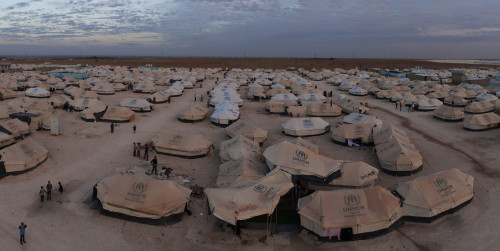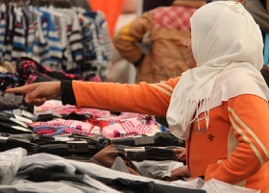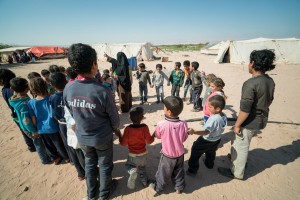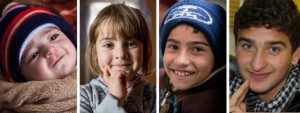
There are 333,837 registered child refugees living in Jordan.
Nine school complexes serve 15,450 children in the Za’atari refugee camp.
And 12 babies are born in the Za’atari Camp per day.
Rows of dust stained caravans can be spotted. The brown soil is flat enough to walk on. In the distance, you can hear children chattering and playing and learning in the Makanis (learning centres). This is the Za’atari Camp, one of Jordan’s refugee camps for Syrian refugees.
“ The refugees established mosque areas and a marketplace. Also, there’s lots of shops. It’s a small town, not a refugee camp.” Mr. Pradhan describes the Za’atari atmosphere. At one point, there were 120,000 refugees living here.

A girl picks her clothing in one of the shops.
I was interviewing Mr. Miraj Pradhan by Skype, the head of UNICEF Communications in Jordan about his experience with the Syrian child refugees residing in Za’atari.
“For a child living in the camp, it is not easy. Many Syrian child refugees come from places with vivid greenery when some of them resided in the countryside. When they come to Za’atari Camp, it is flat land. The landscape is a big change for them.”

Children playing in the camp.
“I remembered a 15 year old boy who talked about his experience.” Mr. Pradhan explains that his work requires him to record the journey of refugees coming into the Za’atari Camp. He narrates the most striking story he has heard of.
He tells me the story of Hassan and his father who fled Syria. “Hassan was on his way to school when he heard gunfire.” Hassan’s father told Mr. Pradhan that “When we were running away, bombs started to explode everywhere and we were jumping over bodies”.
“That’s an experience no child should ever face.” Mr. Pradhan commented sadly.
UNICEF Jordan provides education and psycho-social support for child refugees such as Hassan at Za’atari. There are about 21 Makanis (“My Space” in Arabic) learning centres teaching technical skills such as computer science and music for over 3,045 children. In addition, there are nine schools that provide formal education for 15,450 students.

Girls learning at a Makani.
“ We don’t have 100% enrollment” Mr. Pradhan explains that some families need their children to work or some children have never attended school or some families hope they can return to Syria soon.
“It’s the waiting part that most children find difficult.” He tells me another challenge the children face in the camp. “If you want to go out, you need a permit. You get the mental feeling that it is a closed environment.”
“Yet, many of the families are so full of hope despite all the challenges.” He met a Syrian shoemaker Mohammed along with his two daughters Sidra and Farah while discussing daily living conditions. “His two daughters are very open to strangers, normally, when we go, many of the kids don’t open up to strangers.” Mr. Pradhan remarked surprisingly.

“Despite what you hear in the news, the children are full of hope. We cannot afford to let them down. If they haven’t given up, we cannot give up. We do our service work to let them know that the world has not let them down.”
Please share this article to raise awareness about the plight of the Syrian refugees. In addition, feel free to browse and follow UNICEF Jordan’s social media accounts to learn more:
Photo credit: UNICEF Jordan and Harvard Humanitarian Initiative


